Unit 5 Learning from nature Using language课件(共44张)外研版(2019)选择性必修 第三册
文档属性
| 名称 | Unit 5 Learning from nature Using language课件(共44张)外研版(2019)选择性必修 第三册 | 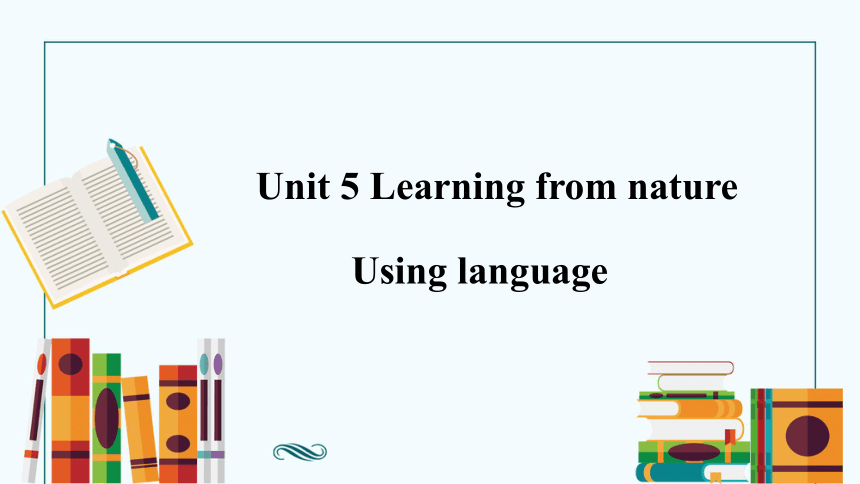 | |
| 格式 | pptx | ||
| 文件大小 | 5.2MB | ||
| 资源类型 | 教案 | ||
| 版本资源 | 外研版(2019) | ||
| 科目 | 英语 | ||
| 更新时间 | 2025-04-26 20:40:05 | ||
图片预览


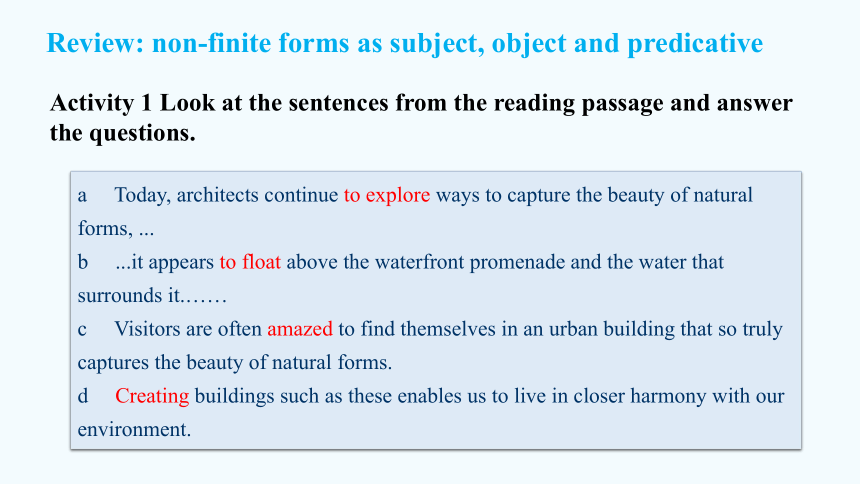
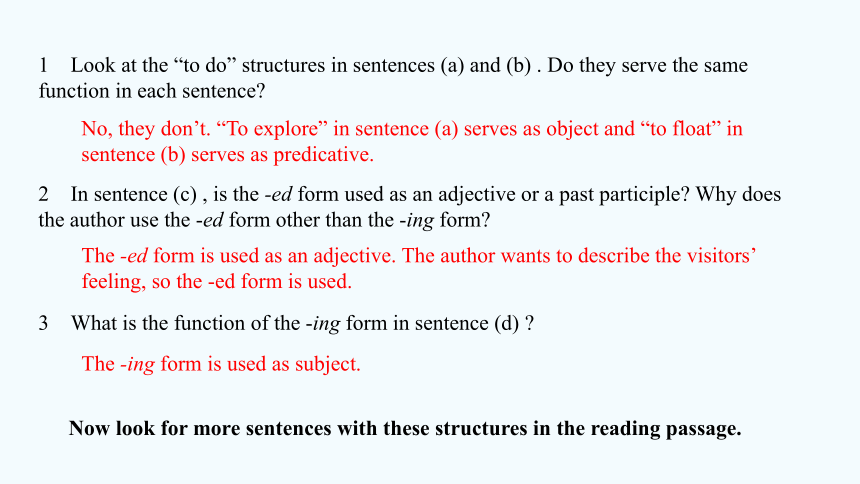
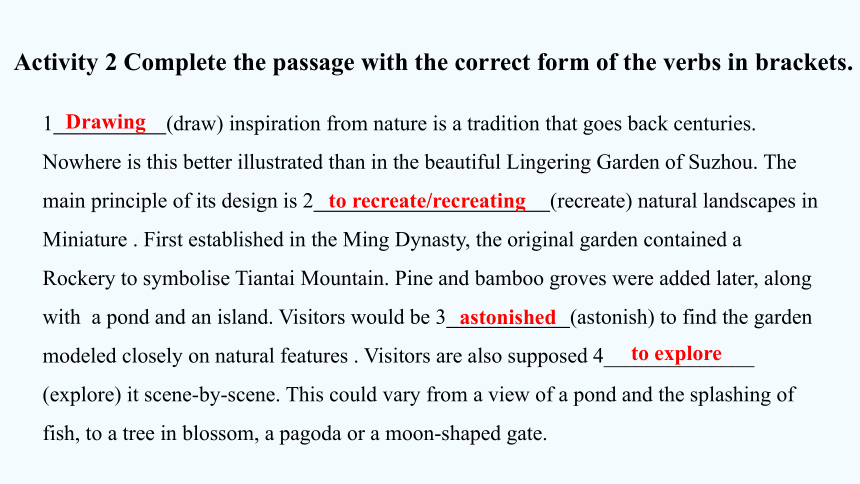

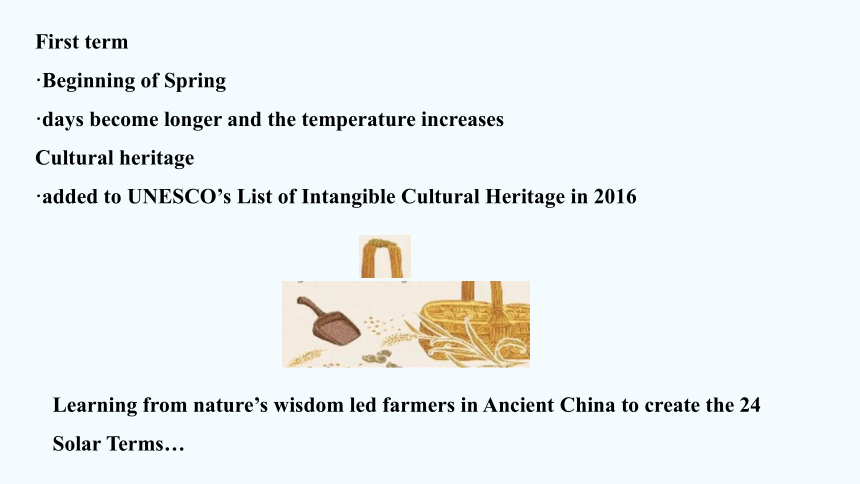
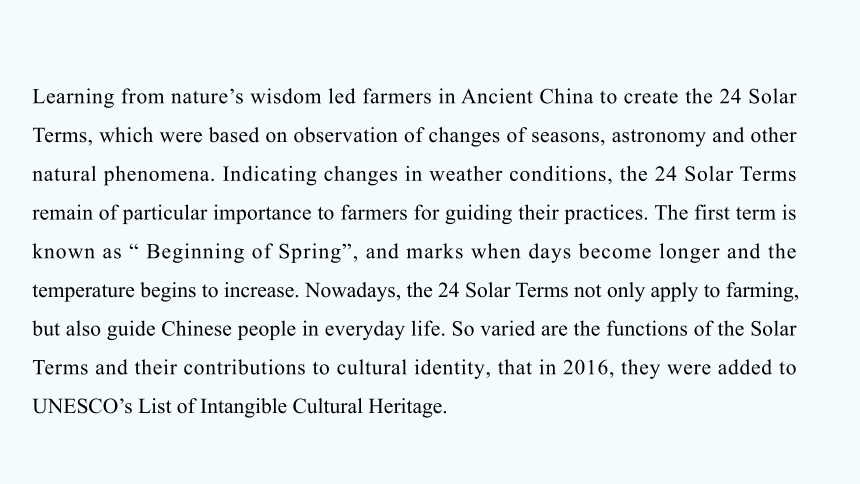
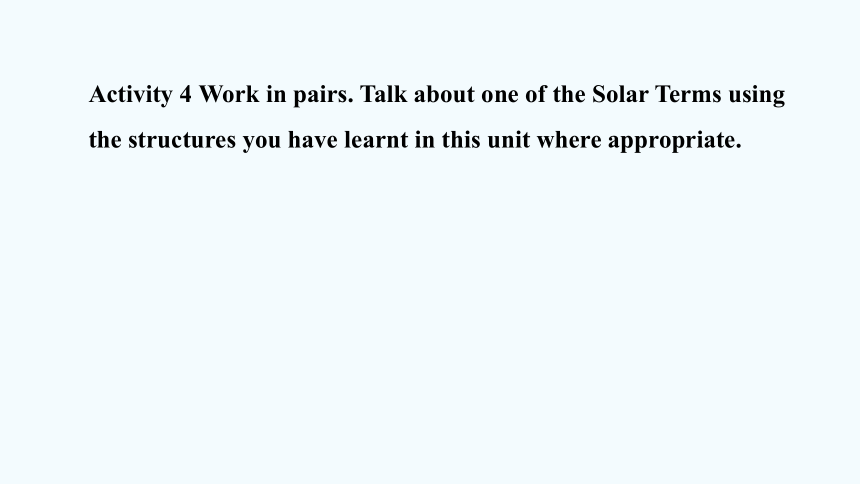
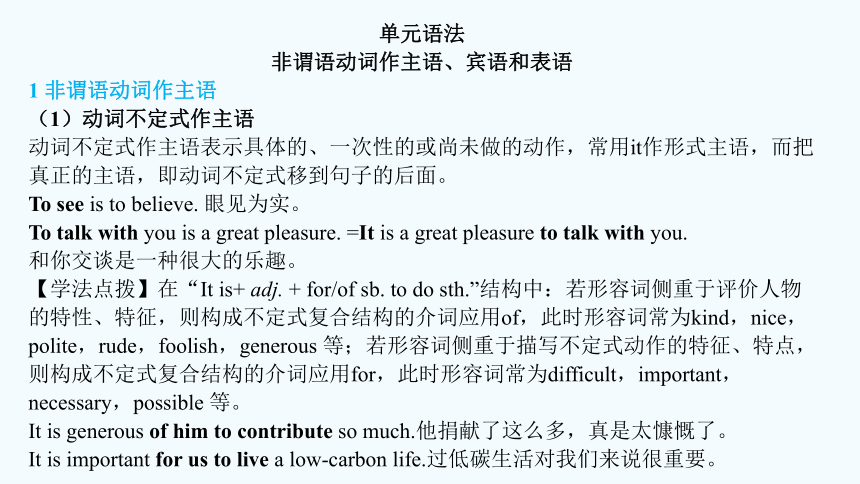
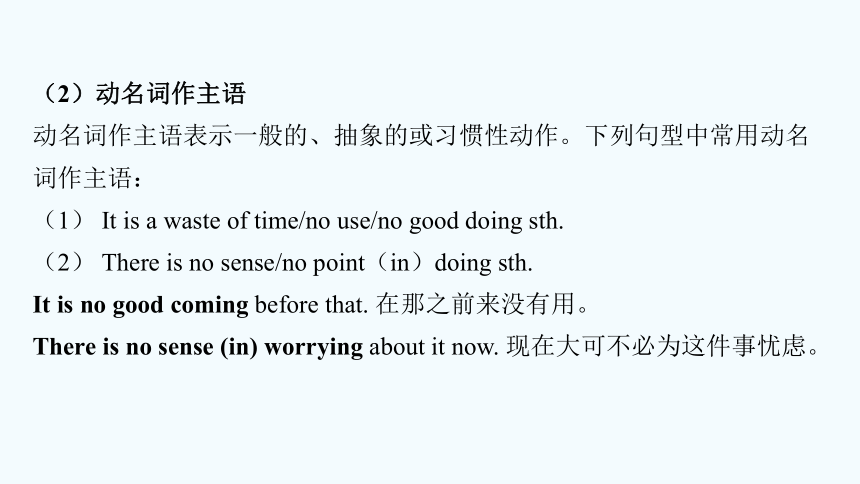
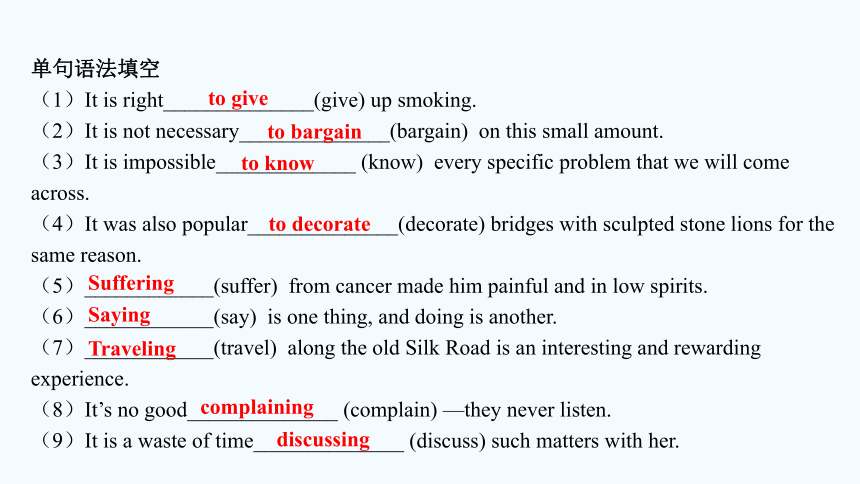
文档简介
(共44张PPT)
Using language
Unit 5 Learning from nature
Learning objectives
1. To review the usage of non-finite forms as subject, object and predicative;
2. To use non-finite forms as subject, object and predicative;
3. To read for and talk about how human take inspiration from animals;
4. To listen for and say how Chinese exercises inspired by animals.
Review: non-finite forms as subject, object and predicative
Activity 1 Look at the sentences from the reading passage and answer the questions.
a Today, architects continue to explore ways to capture the beauty of natural forms, ...
b ...it appears to float above the waterfront promenade and the water that surrounds it.……
c Visitors are often amazed to find themselves in an urban building that so truly captures the beauty of natural forms.
d Creating buildings such as these enables us to live in closer harmony with our environment.
1 Look at the “to do” structures in sentences (a) and (b) . Do they serve the same function in each sentence
2 In sentence (c) , is the -ed form used as an adjective or a past participle Why does the author use the -ed form other than the -ing form
3 What is the function of the -ing form in sentence (d)
No, they don’t. “To explore” in sentence (a) serves as object and “to float” in sentence (b) serves as predicative.
The -ed form is used as an adjective. The author wants to describe the visitors’ feeling, so the -ed form is used.
The -ing form is used as subject.
Now look for more sentences with these structures in the reading passage.
Activity 2 Complete the passage with the correct form of the verbs in brackets.
1 (draw) inspiration from nature is a tradition that goes back centuries. Nowhere is this better illustrated than in the beautiful Lingering Garden of Suzhou. The main principle of its design is 2 (recreate) natural landscapes in Miniature . First established in the Ming Dynasty, the original garden contained a Rockery to symbolise Tiantai Mountain. Pine and bamboo groves were added later, along with a pond and an island. Visitors would be 3 (astonish) to find the garden modeled closely on natural features . Visitors are also supposed 4______________ (explore) it scene-by-scene. This could vary from a view of a pond and the splashing of fish, to a tree in blossom, a pagoda or a moon-shaped gate.
Drawing
to recreate/recreating
astonished
to explore
Activity 3 Read the information below and write a paragraph introducing the 24 Solar Terms with the words in the box. Use the structures you have learnt in this unit where appropriate.
Origin
·created by farmers in Ancient China
·based on Chinese lunar calendar
·determined by the changes in the position of the sun
Significance
·changes in weather mean a lot to farmers
·determine the best time to sow and harvest
·wisdom learnt from nature
learn determine show amaze use
First term
·Beginning of Spring
·days become longer and the temperature increases
Cultural heritage
·added to UNESCO’s List of Intangible Cultural Heritage in 2016
Learning from nature’s wisdom led farmers in Ancient China to create the 24 Solar Terms…
Learning from nature’s wisdom led farmers in Ancient China to create the 24 Solar Terms, which were based on observation of changes of seasons, astronomy and other natural phenomena. Indicating changes in weather conditions, the 24 Solar Terms remain of particular importance to farmers for guiding their practices. The first term is known as “ Beginning of Spring”, and marks when days become longer and the temperature begins to increase. Nowadays, the 24 Solar Terms not only apply to farming, but also guide Chinese people in everyday life. So varied are the functions of the Solar Terms and their contributions to cultural identity, that in 2016, they were added to UNESCO’s List of Intangible Cultural Heritage.
Activity 4 Work in pairs. Talk about one of the Solar Terms using the structures you have learnt in this unit where appropriate.
单元语法
非谓语动词作主语、宾语和表语
1 非谓语动词作主语
(1)动词不定式作主语
动词不定式作主语表示具体的、一次性的或尚未做的动作,常用it作形式主语,而把真正的主语,即动词不定式移到句子的后面。
To see is to believe. 眼见为实。
To talk with you is a great pleasure. =It is a great pleasure to talk with you.
和你交谈是一种很大的乐趣。
【学法点拨】在“It is+ adj. + for/of sb. to do sth.”结构中:若形容词侧重于评价人物的特性、特征,则构成不定式复合结构的介词应用of,此时形容词常为kind,nice,polite,rude,foolish,generous 等;若形容词侧重于描写不定式动作的特征、特点,则构成不定式复合结构的介词应用for,此时形容词常为difficult,important,necessary,possible 等。
It is generous of him to contribute so much.他捐献了这么多,真是太慷慨了。
It is important for us to live a low-carbon life.过低碳生活对我们来说很重要。
(2)动名词作主语
动名词作主语表示一般的、抽象的或习惯性动作。下列句型中常用动名词作主语:
(1) It is a waste of time/no use/no good doing sth.
(2) There is no sense/no point(in)doing sth.
It is no good coming before that. 在那之前来没有用。
There is no sense (in) worrying about it now. 现在大可不必为这件事忧虑。
单句语法填空
(1)It is right______________(give) up smoking.
(2)It is not necessary______________(bargain) on this small amount.
(3)It is impossible_____________ (know) every specific problem that we will come across.
(4)It was also popular______________(decorate) bridges with sculpted stone lions for the same reason.
(5)____________(suffer) from cancer made him painful and in low spirits.
(6)____________(say) is one thing, and doing is another.
(7)____________(travel) along the old Silk Road is an interesting and rewarding experience.
(8)It’s no good______________ (complain) —they never listen.
(9)It is a waste of time______________ (discuss) such matters with her.
to give
to bargain
to know
to decorate
Suffering
Saying
Traveling
complaining
discussing
2 非谓语动词作宾语
1)动词不定式作宾语
(1)常跟不定式作宾语的动词:
决心学会想希望(decide/determine, learn, want, expect/hope/wish)
拒绝设法愿假装(refuse, manage, care, pretend)
主动答应选计划(offer, promise, choose, plan)
同意请求帮一帮(agree, ask/beg, help)
(2)动词tell, show, understand, know, explain, teach, learn, advise 等常接“疑问词+ 不定式”作宾语。
Please tell me when to start the project.请告诉我何时开始这个项目。
(3)不定式作宾语时,如果还带有宾语补足语,往往用it 作形式宾语,而把不定式放在宾补之后。常用句型:主语+find/feel/think/believe/consider/make + it + adj. /n. +to do sth.
We think it our duty to protect the environment. 我们认为保护环境是我们的责任。
2)动名词作宾语
(1)常跟动名词作宾语的动词(短语):
考虑建议盼原谅(consider, suggest/advise, look forward to, excuse/pardon)
承认推迟没得想(admit, delay/put off, fancy)
避免错过继续练(avoid, miss, keep/keep on, practice)
否认完成就欣赏(deny, finish, enjoy/appreciate)
禁止想象才冒险(forbid, imagine, risk)
不禁介意准逃亡(can’t help, mind, allow/permit, escape)
(2)由“动词+ 介词”构成的短语,其后跟动名词作宾语,常见的有be/get used to(习惯于),feel like(想要),insist on/stick to(坚持),get down to(开始认真做……),devote...to...(致力于……),object to(反对),give up(放弃)等。
It’s time I got down to thinking about that essay. 我该认真思考一下那篇文章了。
(3)下列动词(短语)既可以接动名词作宾语,也可以接不定式作宾语,
但意义上有区别。
mean to do sth. 打算做某事 mean doing sth. 意味着做某事
stop to do sth. 停下来去做某事 stop doing sth. 停止做某事
forget to do sth. 忘记去做某事 forget doing sth. 忘记做过某事
remember to do sth. 记住去做某事 remember doing sth. 记得做过某事
regret to do sth. 对要做的事感到遗憾 regret doing sth. 对做过的事感到后悔
try to do sth. 努力去做某事 try doing sth. 尝试做某事
go on to do sth. 继续做另一件事 go on doing sth. 继续做原来做的事
单句语法填空
(1)I don’t know how they managed____________(bring) up four children.
(2)You can imagine how excited I was when I saw the bike,and I begged my uncle to teach me how___________(ride) it right away.
(3)Wherever he is, he made it a rule_____________(take) part in physical labour.
(4)There is no doubt that the event will attract more visitors to enjoy_____________(visit)this wonderful city.
(5)I believe some of you once dreamed of ____________(become) famous.
(6)Instead of trying_____________(make) up for lost time,as many might do,he resigned on the spot.
to bring
to ride
to take
visiting
becoming
to make
(7)I avoided______________ (mention) the subject in case he should be offended.
(8)It’s quite hot today. Do you feel like___________(go) for a swim
(9)You could easily pay with your smartphone by______________(scan) the seller’s QR code.
(10)I find it very interesting_____________(study)English.
(11)I regret___________(tell)you that you can’t be my assistant for your broken English.
(12)These new orders for our products will mean_____________(work)overtime.
(13)Please remember____________(give) me a phone call when you get there.
(14)Adam forgot_____________________(make) an appointment with me yesterday. I waited him the whole afternoon.
(15)We really can’t go on____________ (live)like this—we’ll have to find a bigger house.
mentioning
going
scanning
to study
to tell
working
to give
making/having made
living
3 非谓语动词作表语
(1)动词不定式或动名词作表语
动词不定式作表语表示某一次具体的、特定的或有待实现的动作,而动名词作表语表示通常的情况。
My dream is to enter Peking University. 我的梦想是考入北京大学。
My job is teaching you English. 我的工作是教你们英语。
(2)分词作表语
表示事物的特征或性质时,表语用现在分词;表示人的内心感受时,表语用过去分词。
Please describe a dog that is frightening. 请描述一只令人害怕的狗。
Please describe a dog that is frightened. 请描述一只受惊的狗。
单句语法填空
(1)She looked_______________(disappoint) at the bad news.
(2)To do that would be____________(cut) the foot to fit the shoe.
(3)The children are just beginning to get___________(excite) about using words and forming sentences.
(4)It is very______________ (satisfy) to know that the project was a success.
(5)Because each year’s picture was decided on during the winter, the drawings became ___________(know) as winter counts.
disappointed
to cut
excited
satisfying
known
Inspiration from animals
Activity 5 Read the passage about biomimicry and answer the questions. Pay attention to the words and expressions in bold.
When solving a design problem, you can sometimes look to nature for a solution. One of the early examples is the study of birds to enable human flight. The Wright brothers, who succeeded in creating and flying the first aeroplane in 1903, got their inspiration from observing pigeons in flight. This approach, called biomimicry, studies and imitates nature’s designs and processes to seek solutions to human problems. There are many types of biomimicry, among which the most common one is copying form and shape. By imitating the beak of a bird,for example, bullet trains can be made to run much faster and more quietly. Another type of biomimicry is taking inspiration from the abilities of animals. Inspired by dolphins, people have learnt how to send signals underwater, which is currently employed in tsunami early-warning systems.
One is copying form and shape. Another one is taking inspiration from the abilities of animals.
Many major inventions are derived from the types of biomimicry.
1 What are the types of biomimicry mentioned in the passage What else do you know about them
2 What other examples of biomimicry can you think of Share them with the class.
Wind turbines modeling on Humpback whales; Antimicrobial films mimicking sharkskin; Absorbing shock like a woodpecker
Activity 6 Complete the information with the words and expressions in Activity 5.
Bats use sound to “see”. But how do they avoid crashing into each other The answer lies in their use of echolocation to identify the position of objects. Scientists are 1__________
_______________bats to improve radar systems.
As a land species, how can we improve our performance in water 2__________the shape of the Scales on a shark’s skin,we have created swimsuits that allow swimmers to swim much faster.
By 3____________
Dragonflies in flight, people have realised there are better ways of flying. Now we are 4_______________ dragonflies with our designs for small drones.
taking
Spider silk is much stronger than the same weight of steel. This means that it could be used in lots of products, such as bullet-proof clothing. But we are still 5____________________ one problem—how to get spiders to produce enough silk!
Copying
inspiration from
observing
inspired by
seeking solutions to
Activity 7 Work in pairs. Talk about in what other ways we can learn from animals. Give examples.
Activity 8 Read the passage and answer the questions.
One of the outstanding features of traditional Chinese martial arts is the way they imitate animal movements. This came about because many Chinese martial artists admired the natural instincts,senses and fighting abilities that animals possess in order to survive in the wild.
The first set of animal-imitating exercises came into being about 2,000 years ago. It was called Wu Qin Xi, or Five-animal Exercises, created by Hua Tuo (ca 145-208). As a physician during the Han Dynasty, Hua Tuo is often credited with being the first in China to use anesthesia during surgery. He was known as the best physician of his time, and was an expert in acupuncture.
1 Why were Chinese martial artists inspired by animal movements
2 What were Hua Tuo’s achievements
Because many Chinese martial artists admired the natural instincts, senses and fighting abilities that animals possess in order to survive in the wild.
Hua Tuo created Wu Qin Xi. He was the first physician to use anesthesia during surgery in China. He was known as the best physician of his time and he was an expert in acupuncture.
Activity 9 Listen to the conversation about Wu Qin Xi and tick the topics mentioned by the speakers.
□ The creator of Wu Qin Xi
□ Who can practise the exercises
□ Why these animals were chosen
□ Physical benefits
□ Mental benefits
□ How to teach the exercises
√
√
√
Jim: I saw you in the park this morning doing some sort of slow movements. What was that all about Is it a new type of dance
Wei: New Not at all! It’s a form of physical exercise created by Hua Tuo, almost 2, 000 years ago.
Jim: Uh...what’s it called
Wei: Wu Qin Xi. It means “Five-animal Exercises”.
Jim: Five animals Which ones are they
Wei: Well, they’re the tiger, deer, bear, monkey and crane. Each animal is identified with a form of exercise.
Jim: What are the physical benefits of Wu Qin Xi
Wei: By doing these exercises, you learn from these animals and help your organs to work better. For example, the tiger exercise does good to the liver.
Jim: Really And what do people gain from the bear exercise
Wei: It helps people to have good digestion.
Jim: How does it help people to have good digestion
>听力文本
Wei: Well, it begins with rubbing your body, just as a bear does, to warm your stomach.
Jim: Ah! What about the other three exercises
Wei: Well, the monkey exercise helps the heart to work well; the deer exercise is good for the kidney; and the crane exercise is good for the lung.
Jim: Wow, that’s interesting! Anything else
Wei: Some people believe that Wu Qin Xi helps you to live to an advanced age. There are stories of Wu Qin Xi masters living to more than 90 years of age, and still having good eyesight, hearing and strong teeth.
Jim: That’s very impressive.
Wei: Yes, Wu Qin Xi has mental benefits, too. It can help to relax your mind and improve concentration.
Jim: Sounds great! Can you teach me how to do Wu Qin Xi
Wei: Sure. You can join me every morning.
Jim: Oh, no. I don’t think I can get up so early every day. I’m always too tired.
Wei: Sounds like you do need some Wu Qin Xi exercises!
Activity 10 Listen again and complete the introduction to Wu Qin Xi.
Wu Qin Xi was created by Hua Tuo almost 2,000 years ago. It means “Five-animal Exercises”, and each animal is 1 . By doing these exercises, people learn from these animals and help 2_____________________________. For example, the tiger exercise 3 the liver. The bear exercise helps people with good digestion. The monkey exercise helps 4 ; the
______________is good for the kidney; and the crane exercise is 6 . Some people believe Wu Qin Xi helps them 7 . Some of the Wu Qin Xi masters lived to 8 , and still had good eyesight, hearing and strong teeth. Wu Qin Xi has 9 , too. It can help 10________ ___________________________________.
identified with a form of exercise
the/their organs to work better
does good to
the heart to work well
deer exercise
good for the lung
to live to an advanced age
more than 90 years of age
mental benefits
to relax
the mind and improve concentration
Activity 11 Complete the boxes with the expressions from the conversation.
Talking about benefits Showing interest
By..., you learn...
It helps people to...
...is good for...
Really
That’s interesting!
That’s very impressive.
Sounds great!
·By..., you learn... ·That’s interesting!
·Really ·That’s very impressive.
·t helps people to... ·Sounds great!
·... is good for...
Activity 12 Work in pairs. Think about other exercises inspired by animals. Discuss how they were created and their benefits,using the words and expressions in this section.
Now think about your performance. How well can you use the language you have learnt to talk about traditional Chinese exercises
1. (教材原句p.54) This approach, called biomimicry, studies and imitates nature’s designs and processes to seek solutions to human problems.
这种方法被称为仿生学,研究和模仿大自然的设计和过程,以寻求解决人类问题的方法。
seek solutions to 寻求……的解决方法(to 是介词)
The company is still seeking solutions to its current problems.
公司仍在寻求解决目前问题的办法。
【归纳拓展】
the solution to... ……的解决办法(to 是介词)
look for a solution 寻找解决办法
find/come up with a solution 找到/ 想出解决办法
provide/offer a solution 提供解决办法
We haven’t found the solution yet, but I’m sure we’re on the right track.
我们还没有找到解决办法,但我肯定我们的思路是对的。
Language points
单句语法填空
(1)I have tried very hard to find a solution ____ the problem,but in vain.
(2)They have begun to look seriously into the reasons and seek______________ (solve) to the problem.
(3)Increasing employment is one of the solutions to___________(reduce)crimes.
完成句子
(4)All you had to do was think a little harder and__________________________(想出一个新的解决办法).
solutions
reducing
come up with a new solution
to
2. (教材原句p.54 ) Another type of biomimicry is taking inspiration from the abilities of animals.
另一种仿生学是从动物的能力中获得灵感。
take inspiration from 从……中获取灵感
The artist took inspiration from African art.
这位艺术家从非洲艺术中获得灵感。
【归纳拓展】
draw/get inspiration from 从……中得到灵感 provide inspiration for 为……提供灵感
look for/seek inspiration 寻找灵感 need/lack inspiration 需要/ 缺乏灵感
Many poets and artists have drawn their inspiration from nature.
许多诗人和艺术家都从大自然中得到灵感。
单句语法填空
(1)Scientists take inspiration____________ nature to make their breakthrough.
(2) He drew much______________(inspire) from art produced by children and by primitive cultures.
完成句子
(3)The sea has ________________________(为……提供灵感)many of his paintings.
(4)I cannot finish the work today because I_________________(缺乏灵感).
from
inspiration
provided inspiration for
lack inspiration
3. (教材原句p.54) ...people have learnt how to send signals underwater,which is currently employed in tsunami early-warning systems.
……人们学会了如何在水下发送信号,这种方法目前被用于海啸预警系统。
employ v. 使用,运用;雇用;花时间做,忙于做
搭配: employ sb. as sth. 雇用某人当…… employ sb. to do sth. 雇用某人做某事
be employed in (doing) sth. 忙于(做)某事
Different artists employ different painting techniques. 不同的画家运用不同的绘画技巧。
For the past three years he has been employed as a firefighter. 三年来他一直受雇当消防员。
The children were employed in painting. 孩子们忙于画画。
【单词积累】
employer n. 雇主 employee n. 雇员 employment n. 就业;工作;使用
单句语法填空
(1)The report examines teaching methods _____________(employ) in the classroom.
(2)Can’t we employ someone _____ an assistant to help with all this paperwork
(3)A number of people have been employed ___________(deal) with the work.
(4)The new factory will provide ___________(employ) for about a hundred local people.
完成句子
(5)She ______________________________(忙于列一个清单)of all the jobs to be done.
employed
as
to deal
employment
is employed in making a list
4. (教材原句p.55 ) The first set of animal-imitating exercises came into being about 2,000 years ago.
最早的一套模仿动物的练习大约出现在2000 年前。
come into being (= come into existence) 诞生;出现;存在
We don’t know how life first came into being.
我们不知道生命最初是如何诞生的。
No one knows for certain when such a custom came into being.
没有人确切地知道这种风俗是什么时候形成的。
【误区警示】come into being 无被动语态,也不能用于进行时态。
【归纳拓展】
come into effect 生效,开始实施 come into view 进入视野
come into fashion 开始流行 come into use 开始使用
完成句子
(1)Scientists have many theories about how the universe _________________________(诞生).
(2)The cloud lifted, and the tops of the mountains suddenly________________(进入视野).
(3)The church wedding ceremony has ___________________(流行起来)there.
(4)It is said that the new regulation will not ___________________(开始实施)until the end of net month.
came into being/existence
came into view
come into fashion
come into effect
5.(教材原句p.55) ...Hua Tuo is often credited with being the first in China to use anesthesia during surgery.
……华佗通常被认为是中国第一个在手术中使用麻醉的人。
be credited with 被认为……;认为……是……的功劳
He is credited with originating a new printing process.
人们认为他发明了一种新的印刷方法。
The company is credited with inventing the industrial robot.
发明工业机器人是那家公司的功劳。
【归纳拓展】
be credited to sb. /sth. 归功于某人/ 某事;某人/ 某事是……发生的原因
The invention of the industrial robot is credited to the company.
工业机器人的发明应归功于那家公司。
完成句子
(1)他被认为是发明第一架真正的直升机的人。
He __________________ inventing the first true helicopter.
(2)公司的成功归功于她。
She_____________________ making the business a success.
(3)Much of Manchester United’s success can ________________(归功于)their manager.
is credited with
is credited with
be credited to
6. (教材原句p.53) Nowhere is this better illustrated than in the beautiful Lingering Garden of Suzhou.
没有什么地方比美丽的苏州留园更能说明这一点。
【 句法分析】本句使用了“否定词 + 比较级”结构,否定词 nowhere与比较级 better 连用,表示最高级含义。
“否定词 + 比较级”表示最高级含义
(1)基本结构:否定词 + 形容词或副词的比较级(+ than)
(2)常用的否定词:no, not, nevert, nothingt, nobodyt, nowheret, hardly 等
(3)意义:再没有更……的了,再……不过了
Nothing is more precious than health. 健康是最宝贵的。
I have never seen a more energetic man.我从未见过比他精力更充沛的人。
I couldn’t agree more. 我完全同意 / 再同意不过了。
【归纳拓展】比较级形式表示最高级含义的其他结构:
any other + 单数名词 any of the other + 复数名词
比较级+ than + any of the others all the other + 复数名词
all the others anyone/anything else
单句语法填空
(1)No one could be__________________(generous); he has a heart of gold.
(2)Mr. Stevenson is great to work for—I really couldn’t ask for a___________(good)boss.
(3)Nothing is________________(pleasant)than staying home listening to music.
(4)The weather couldn’t be__________(bad), so we will not go out.
(5)I suddenly realised nobody was____________(happy) than I was.
一句多译
中国的人口比世界上任何一个国家的人口都多。
(6)The population of China is larger than that of____________ country in the world.
(7)The population of China is larger than that of ________________________________ countries in the world.
more generous
better
more pleasant
worse
happier
any other
any of the other/ all the other
Using language
Unit 5 Learning from nature
Learning objectives
1. To review the usage of non-finite forms as subject, object and predicative;
2. To use non-finite forms as subject, object and predicative;
3. To read for and talk about how human take inspiration from animals;
4. To listen for and say how Chinese exercises inspired by animals.
Review: non-finite forms as subject, object and predicative
Activity 1 Look at the sentences from the reading passage and answer the questions.
a Today, architects continue to explore ways to capture the beauty of natural forms, ...
b ...it appears to float above the waterfront promenade and the water that surrounds it.……
c Visitors are often amazed to find themselves in an urban building that so truly captures the beauty of natural forms.
d Creating buildings such as these enables us to live in closer harmony with our environment.
1 Look at the “to do” structures in sentences (a) and (b) . Do they serve the same function in each sentence
2 In sentence (c) , is the -ed form used as an adjective or a past participle Why does the author use the -ed form other than the -ing form
3 What is the function of the -ing form in sentence (d)
No, they don’t. “To explore” in sentence (a) serves as object and “to float” in sentence (b) serves as predicative.
The -ed form is used as an adjective. The author wants to describe the visitors’ feeling, so the -ed form is used.
The -ing form is used as subject.
Now look for more sentences with these structures in the reading passage.
Activity 2 Complete the passage with the correct form of the verbs in brackets.
1 (draw) inspiration from nature is a tradition that goes back centuries. Nowhere is this better illustrated than in the beautiful Lingering Garden of Suzhou. The main principle of its design is 2 (recreate) natural landscapes in Miniature . First established in the Ming Dynasty, the original garden contained a Rockery to symbolise Tiantai Mountain. Pine and bamboo groves were added later, along with a pond and an island. Visitors would be 3 (astonish) to find the garden modeled closely on natural features . Visitors are also supposed 4______________ (explore) it scene-by-scene. This could vary from a view of a pond and the splashing of fish, to a tree in blossom, a pagoda or a moon-shaped gate.
Drawing
to recreate/recreating
astonished
to explore
Activity 3 Read the information below and write a paragraph introducing the 24 Solar Terms with the words in the box. Use the structures you have learnt in this unit where appropriate.
Origin
·created by farmers in Ancient China
·based on Chinese lunar calendar
·determined by the changes in the position of the sun
Significance
·changes in weather mean a lot to farmers
·determine the best time to sow and harvest
·wisdom learnt from nature
learn determine show amaze use
First term
·Beginning of Spring
·days become longer and the temperature increases
Cultural heritage
·added to UNESCO’s List of Intangible Cultural Heritage in 2016
Learning from nature’s wisdom led farmers in Ancient China to create the 24 Solar Terms…
Learning from nature’s wisdom led farmers in Ancient China to create the 24 Solar Terms, which were based on observation of changes of seasons, astronomy and other natural phenomena. Indicating changes in weather conditions, the 24 Solar Terms remain of particular importance to farmers for guiding their practices. The first term is known as “ Beginning of Spring”, and marks when days become longer and the temperature begins to increase. Nowadays, the 24 Solar Terms not only apply to farming, but also guide Chinese people in everyday life. So varied are the functions of the Solar Terms and their contributions to cultural identity, that in 2016, they were added to UNESCO’s List of Intangible Cultural Heritage.
Activity 4 Work in pairs. Talk about one of the Solar Terms using the structures you have learnt in this unit where appropriate.
单元语法
非谓语动词作主语、宾语和表语
1 非谓语动词作主语
(1)动词不定式作主语
动词不定式作主语表示具体的、一次性的或尚未做的动作,常用it作形式主语,而把真正的主语,即动词不定式移到句子的后面。
To see is to believe. 眼见为实。
To talk with you is a great pleasure. =It is a great pleasure to talk with you.
和你交谈是一种很大的乐趣。
【学法点拨】在“It is+ adj. + for/of sb. to do sth.”结构中:若形容词侧重于评价人物的特性、特征,则构成不定式复合结构的介词应用of,此时形容词常为kind,nice,polite,rude,foolish,generous 等;若形容词侧重于描写不定式动作的特征、特点,则构成不定式复合结构的介词应用for,此时形容词常为difficult,important,necessary,possible 等。
It is generous of him to contribute so much.他捐献了这么多,真是太慷慨了。
It is important for us to live a low-carbon life.过低碳生活对我们来说很重要。
(2)动名词作主语
动名词作主语表示一般的、抽象的或习惯性动作。下列句型中常用动名词作主语:
(1) It is a waste of time/no use/no good doing sth.
(2) There is no sense/no point(in)doing sth.
It is no good coming before that. 在那之前来没有用。
There is no sense (in) worrying about it now. 现在大可不必为这件事忧虑。
单句语法填空
(1)It is right______________(give) up smoking.
(2)It is not necessary______________(bargain) on this small amount.
(3)It is impossible_____________ (know) every specific problem that we will come across.
(4)It was also popular______________(decorate) bridges with sculpted stone lions for the same reason.
(5)____________(suffer) from cancer made him painful and in low spirits.
(6)____________(say) is one thing, and doing is another.
(7)____________(travel) along the old Silk Road is an interesting and rewarding experience.
(8)It’s no good______________ (complain) —they never listen.
(9)It is a waste of time______________ (discuss) such matters with her.
to give
to bargain
to know
to decorate
Suffering
Saying
Traveling
complaining
discussing
2 非谓语动词作宾语
1)动词不定式作宾语
(1)常跟不定式作宾语的动词:
决心学会想希望(decide/determine, learn, want, expect/hope/wish)
拒绝设法愿假装(refuse, manage, care, pretend)
主动答应选计划(offer, promise, choose, plan)
同意请求帮一帮(agree, ask/beg, help)
(2)动词tell, show, understand, know, explain, teach, learn, advise 等常接“疑问词+ 不定式”作宾语。
Please tell me when to start the project.请告诉我何时开始这个项目。
(3)不定式作宾语时,如果还带有宾语补足语,往往用it 作形式宾语,而把不定式放在宾补之后。常用句型:主语+find/feel/think/believe/consider/make + it + adj. /n. +to do sth.
We think it our duty to protect the environment. 我们认为保护环境是我们的责任。
2)动名词作宾语
(1)常跟动名词作宾语的动词(短语):
考虑建议盼原谅(consider, suggest/advise, look forward to, excuse/pardon)
承认推迟没得想(admit, delay/put off, fancy)
避免错过继续练(avoid, miss, keep/keep on, practice)
否认完成就欣赏(deny, finish, enjoy/appreciate)
禁止想象才冒险(forbid, imagine, risk)
不禁介意准逃亡(can’t help, mind, allow/permit, escape)
(2)由“动词+ 介词”构成的短语,其后跟动名词作宾语,常见的有be/get used to(习惯于),feel like(想要),insist on/stick to(坚持),get down to(开始认真做……),devote...to...(致力于……),object to(反对),give up(放弃)等。
It’s time I got down to thinking about that essay. 我该认真思考一下那篇文章了。
(3)下列动词(短语)既可以接动名词作宾语,也可以接不定式作宾语,
但意义上有区别。
mean to do sth. 打算做某事 mean doing sth. 意味着做某事
stop to do sth. 停下来去做某事 stop doing sth. 停止做某事
forget to do sth. 忘记去做某事 forget doing sth. 忘记做过某事
remember to do sth. 记住去做某事 remember doing sth. 记得做过某事
regret to do sth. 对要做的事感到遗憾 regret doing sth. 对做过的事感到后悔
try to do sth. 努力去做某事 try doing sth. 尝试做某事
go on to do sth. 继续做另一件事 go on doing sth. 继续做原来做的事
单句语法填空
(1)I don’t know how they managed____________(bring) up four children.
(2)You can imagine how excited I was when I saw the bike,and I begged my uncle to teach me how___________(ride) it right away.
(3)Wherever he is, he made it a rule_____________(take) part in physical labour.
(4)There is no doubt that the event will attract more visitors to enjoy_____________(visit)this wonderful city.
(5)I believe some of you once dreamed of ____________(become) famous.
(6)Instead of trying_____________(make) up for lost time,as many might do,he resigned on the spot.
to bring
to ride
to take
visiting
becoming
to make
(7)I avoided______________ (mention) the subject in case he should be offended.
(8)It’s quite hot today. Do you feel like___________(go) for a swim
(9)You could easily pay with your smartphone by______________(scan) the seller’s QR code.
(10)I find it very interesting_____________(study)English.
(11)I regret___________(tell)you that you can’t be my assistant for your broken English.
(12)These new orders for our products will mean_____________(work)overtime.
(13)Please remember____________(give) me a phone call when you get there.
(14)Adam forgot_____________________(make) an appointment with me yesterday. I waited him the whole afternoon.
(15)We really can’t go on____________ (live)like this—we’ll have to find a bigger house.
mentioning
going
scanning
to study
to tell
working
to give
making/having made
living
3 非谓语动词作表语
(1)动词不定式或动名词作表语
动词不定式作表语表示某一次具体的、特定的或有待实现的动作,而动名词作表语表示通常的情况。
My dream is to enter Peking University. 我的梦想是考入北京大学。
My job is teaching you English. 我的工作是教你们英语。
(2)分词作表语
表示事物的特征或性质时,表语用现在分词;表示人的内心感受时,表语用过去分词。
Please describe a dog that is frightening. 请描述一只令人害怕的狗。
Please describe a dog that is frightened. 请描述一只受惊的狗。
单句语法填空
(1)She looked_______________(disappoint) at the bad news.
(2)To do that would be____________(cut) the foot to fit the shoe.
(3)The children are just beginning to get___________(excite) about using words and forming sentences.
(4)It is very______________ (satisfy) to know that the project was a success.
(5)Because each year’s picture was decided on during the winter, the drawings became ___________(know) as winter counts.
disappointed
to cut
excited
satisfying
known
Inspiration from animals
Activity 5 Read the passage about biomimicry and answer the questions. Pay attention to the words and expressions in bold.
When solving a design problem, you can sometimes look to nature for a solution. One of the early examples is the study of birds to enable human flight. The Wright brothers, who succeeded in creating and flying the first aeroplane in 1903, got their inspiration from observing pigeons in flight. This approach, called biomimicry, studies and imitates nature’s designs and processes to seek solutions to human problems. There are many types of biomimicry, among which the most common one is copying form and shape. By imitating the beak of a bird,for example, bullet trains can be made to run much faster and more quietly. Another type of biomimicry is taking inspiration from the abilities of animals. Inspired by dolphins, people have learnt how to send signals underwater, which is currently employed in tsunami early-warning systems.
One is copying form and shape. Another one is taking inspiration from the abilities of animals.
Many major inventions are derived from the types of biomimicry.
1 What are the types of biomimicry mentioned in the passage What else do you know about them
2 What other examples of biomimicry can you think of Share them with the class.
Wind turbines modeling on Humpback whales; Antimicrobial films mimicking sharkskin; Absorbing shock like a woodpecker
Activity 6 Complete the information with the words and expressions in Activity 5.
Bats use sound to “see”. But how do they avoid crashing into each other The answer lies in their use of echolocation to identify the position of objects. Scientists are 1__________
_______________bats to improve radar systems.
As a land species, how can we improve our performance in water 2__________the shape of the Scales on a shark’s skin,we have created swimsuits that allow swimmers to swim much faster.
By 3____________
Dragonflies in flight, people have realised there are better ways of flying. Now we are 4_______________ dragonflies with our designs for small drones.
taking
Spider silk is much stronger than the same weight of steel. This means that it could be used in lots of products, such as bullet-proof clothing. But we are still 5____________________ one problem—how to get spiders to produce enough silk!
Copying
inspiration from
observing
inspired by
seeking solutions to
Activity 7 Work in pairs. Talk about in what other ways we can learn from animals. Give examples.
Activity 8 Read the passage and answer the questions.
One of the outstanding features of traditional Chinese martial arts is the way they imitate animal movements. This came about because many Chinese martial artists admired the natural instincts,senses and fighting abilities that animals possess in order to survive in the wild.
The first set of animal-imitating exercises came into being about 2,000 years ago. It was called Wu Qin Xi, or Five-animal Exercises, created by Hua Tuo (ca 145-208). As a physician during the Han Dynasty, Hua Tuo is often credited with being the first in China to use anesthesia during surgery. He was known as the best physician of his time, and was an expert in acupuncture.
1 Why were Chinese martial artists inspired by animal movements
2 What were Hua Tuo’s achievements
Because many Chinese martial artists admired the natural instincts, senses and fighting abilities that animals possess in order to survive in the wild.
Hua Tuo created Wu Qin Xi. He was the first physician to use anesthesia during surgery in China. He was known as the best physician of his time and he was an expert in acupuncture.
Activity 9 Listen to the conversation about Wu Qin Xi and tick the topics mentioned by the speakers.
□ The creator of Wu Qin Xi
□ Who can practise the exercises
□ Why these animals were chosen
□ Physical benefits
□ Mental benefits
□ How to teach the exercises
√
√
√
Jim: I saw you in the park this morning doing some sort of slow movements. What was that all about Is it a new type of dance
Wei: New Not at all! It’s a form of physical exercise created by Hua Tuo, almost 2, 000 years ago.
Jim: Uh...what’s it called
Wei: Wu Qin Xi. It means “Five-animal Exercises”.
Jim: Five animals Which ones are they
Wei: Well, they’re the tiger, deer, bear, monkey and crane. Each animal is identified with a form of exercise.
Jim: What are the physical benefits of Wu Qin Xi
Wei: By doing these exercises, you learn from these animals and help your organs to work better. For example, the tiger exercise does good to the liver.
Jim: Really And what do people gain from the bear exercise
Wei: It helps people to have good digestion.
Jim: How does it help people to have good digestion
>听力文本
Wei: Well, it begins with rubbing your body, just as a bear does, to warm your stomach.
Jim: Ah! What about the other three exercises
Wei: Well, the monkey exercise helps the heart to work well; the deer exercise is good for the kidney; and the crane exercise is good for the lung.
Jim: Wow, that’s interesting! Anything else
Wei: Some people believe that Wu Qin Xi helps you to live to an advanced age. There are stories of Wu Qin Xi masters living to more than 90 years of age, and still having good eyesight, hearing and strong teeth.
Jim: That’s very impressive.
Wei: Yes, Wu Qin Xi has mental benefits, too. It can help to relax your mind and improve concentration.
Jim: Sounds great! Can you teach me how to do Wu Qin Xi
Wei: Sure. You can join me every morning.
Jim: Oh, no. I don’t think I can get up so early every day. I’m always too tired.
Wei: Sounds like you do need some Wu Qin Xi exercises!
Activity 10 Listen again and complete the introduction to Wu Qin Xi.
Wu Qin Xi was created by Hua Tuo almost 2,000 years ago. It means “Five-animal Exercises”, and each animal is 1 . By doing these exercises, people learn from these animals and help 2_____________________________. For example, the tiger exercise 3 the liver. The bear exercise helps people with good digestion. The monkey exercise helps 4 ; the
______________is good for the kidney; and the crane exercise is 6 . Some people believe Wu Qin Xi helps them 7 . Some of the Wu Qin Xi masters lived to 8 , and still had good eyesight, hearing and strong teeth. Wu Qin Xi has 9 , too. It can help 10________ ___________________________________.
identified with a form of exercise
the/their organs to work better
does good to
the heart to work well
deer exercise
good for the lung
to live to an advanced age
more than 90 years of age
mental benefits
to relax
the mind and improve concentration
Activity 11 Complete the boxes with the expressions from the conversation.
Talking about benefits Showing interest
By..., you learn...
It helps people to...
...is good for...
Really
That’s interesting!
That’s very impressive.
Sounds great!
·By..., you learn... ·That’s interesting!
·Really ·That’s very impressive.
·t helps people to... ·Sounds great!
·... is good for...
Activity 12 Work in pairs. Think about other exercises inspired by animals. Discuss how they were created and their benefits,using the words and expressions in this section.
Now think about your performance. How well can you use the language you have learnt to talk about traditional Chinese exercises
1. (教材原句p.54) This approach, called biomimicry, studies and imitates nature’s designs and processes to seek solutions to human problems.
这种方法被称为仿生学,研究和模仿大自然的设计和过程,以寻求解决人类问题的方法。
seek solutions to 寻求……的解决方法(to 是介词)
The company is still seeking solutions to its current problems.
公司仍在寻求解决目前问题的办法。
【归纳拓展】
the solution to... ……的解决办法(to 是介词)
look for a solution 寻找解决办法
find/come up with a solution 找到/ 想出解决办法
provide/offer a solution 提供解决办法
We haven’t found the solution yet, but I’m sure we’re on the right track.
我们还没有找到解决办法,但我肯定我们的思路是对的。
Language points
单句语法填空
(1)I have tried very hard to find a solution ____ the problem,but in vain.
(2)They have begun to look seriously into the reasons and seek______________ (solve) to the problem.
(3)Increasing employment is one of the solutions to___________(reduce)crimes.
完成句子
(4)All you had to do was think a little harder and__________________________(想出一个新的解决办法).
solutions
reducing
come up with a new solution
to
2. (教材原句p.54 ) Another type of biomimicry is taking inspiration from the abilities of animals.
另一种仿生学是从动物的能力中获得灵感。
take inspiration from 从……中获取灵感
The artist took inspiration from African art.
这位艺术家从非洲艺术中获得灵感。
【归纳拓展】
draw/get inspiration from 从……中得到灵感 provide inspiration for 为……提供灵感
look for/seek inspiration 寻找灵感 need/lack inspiration 需要/ 缺乏灵感
Many poets and artists have drawn their inspiration from nature.
许多诗人和艺术家都从大自然中得到灵感。
单句语法填空
(1)Scientists take inspiration____________ nature to make their breakthrough.
(2) He drew much______________(inspire) from art produced by children and by primitive cultures.
完成句子
(3)The sea has ________________________(为……提供灵感)many of his paintings.
(4)I cannot finish the work today because I_________________(缺乏灵感).
from
inspiration
provided inspiration for
lack inspiration
3. (教材原句p.54) ...people have learnt how to send signals underwater,which is currently employed in tsunami early-warning systems.
……人们学会了如何在水下发送信号,这种方法目前被用于海啸预警系统。
employ v. 使用,运用;雇用;花时间做,忙于做
搭配: employ sb. as sth. 雇用某人当…… employ sb. to do sth. 雇用某人做某事
be employed in (doing) sth. 忙于(做)某事
Different artists employ different painting techniques. 不同的画家运用不同的绘画技巧。
For the past three years he has been employed as a firefighter. 三年来他一直受雇当消防员。
The children were employed in painting. 孩子们忙于画画。
【单词积累】
employer n. 雇主 employee n. 雇员 employment n. 就业;工作;使用
单句语法填空
(1)The report examines teaching methods _____________(employ) in the classroom.
(2)Can’t we employ someone _____ an assistant to help with all this paperwork
(3)A number of people have been employed ___________(deal) with the work.
(4)The new factory will provide ___________(employ) for about a hundred local people.
完成句子
(5)She ______________________________(忙于列一个清单)of all the jobs to be done.
employed
as
to deal
employment
is employed in making a list
4. (教材原句p.55 ) The first set of animal-imitating exercises came into being about 2,000 years ago.
最早的一套模仿动物的练习大约出现在2000 年前。
come into being (= come into existence) 诞生;出现;存在
We don’t know how life first came into being.
我们不知道生命最初是如何诞生的。
No one knows for certain when such a custom came into being.
没有人确切地知道这种风俗是什么时候形成的。
【误区警示】come into being 无被动语态,也不能用于进行时态。
【归纳拓展】
come into effect 生效,开始实施 come into view 进入视野
come into fashion 开始流行 come into use 开始使用
完成句子
(1)Scientists have many theories about how the universe _________________________(诞生).
(2)The cloud lifted, and the tops of the mountains suddenly________________(进入视野).
(3)The church wedding ceremony has ___________________(流行起来)there.
(4)It is said that the new regulation will not ___________________(开始实施)until the end of net month.
came into being/existence
came into view
come into fashion
come into effect
5.(教材原句p.55) ...Hua Tuo is often credited with being the first in China to use anesthesia during surgery.
……华佗通常被认为是中国第一个在手术中使用麻醉的人。
be credited with 被认为……;认为……是……的功劳
He is credited with originating a new printing process.
人们认为他发明了一种新的印刷方法。
The company is credited with inventing the industrial robot.
发明工业机器人是那家公司的功劳。
【归纳拓展】
be credited to sb. /sth. 归功于某人/ 某事;某人/ 某事是……发生的原因
The invention of the industrial robot is credited to the company.
工业机器人的发明应归功于那家公司。
完成句子
(1)他被认为是发明第一架真正的直升机的人。
He __________________ inventing the first true helicopter.
(2)公司的成功归功于她。
She_____________________ making the business a success.
(3)Much of Manchester United’s success can ________________(归功于)their manager.
is credited with
is credited with
be credited to
6. (教材原句p.53) Nowhere is this better illustrated than in the beautiful Lingering Garden of Suzhou.
没有什么地方比美丽的苏州留园更能说明这一点。
【 句法分析】本句使用了“否定词 + 比较级”结构,否定词 nowhere与比较级 better 连用,表示最高级含义。
“否定词 + 比较级”表示最高级含义
(1)基本结构:否定词 + 形容词或副词的比较级(+ than)
(2)常用的否定词:no, not, nevert, nothingt, nobodyt, nowheret, hardly 等
(3)意义:再没有更……的了,再……不过了
Nothing is more precious than health. 健康是最宝贵的。
I have never seen a more energetic man.我从未见过比他精力更充沛的人。
I couldn’t agree more. 我完全同意 / 再同意不过了。
【归纳拓展】比较级形式表示最高级含义的其他结构:
any other + 单数名词 any of the other + 复数名词
比较级+ than + any of the others all the other + 复数名词
all the others anyone/anything else
单句语法填空
(1)No one could be__________________(generous); he has a heart of gold.
(2)Mr. Stevenson is great to work for—I really couldn’t ask for a___________(good)boss.
(3)Nothing is________________(pleasant)than staying home listening to music.
(4)The weather couldn’t be__________(bad), so we will not go out.
(5)I suddenly realised nobody was____________(happy) than I was.
一句多译
中国的人口比世界上任何一个国家的人口都多。
(6)The population of China is larger than that of____________ country in the world.
(7)The population of China is larger than that of ________________________________ countries in the world.
more generous
better
more pleasant
worse
happier
any other
any of the other/ all the other
